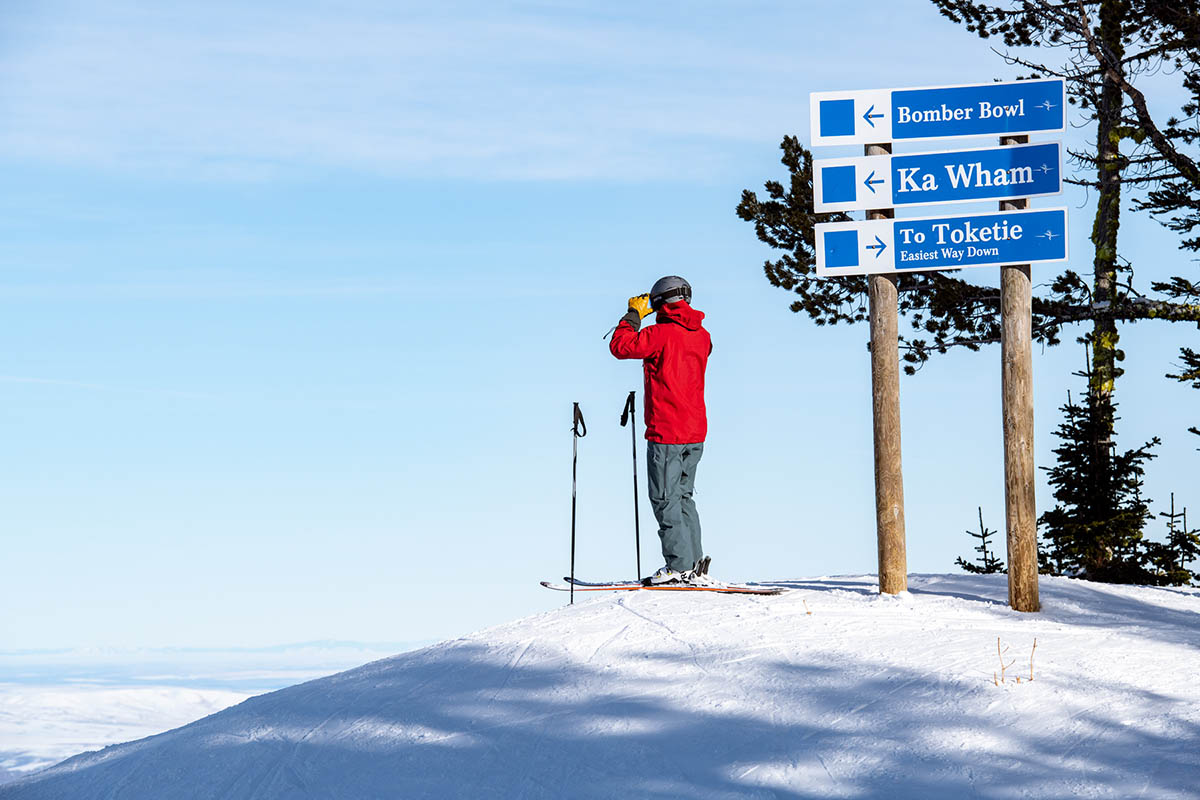
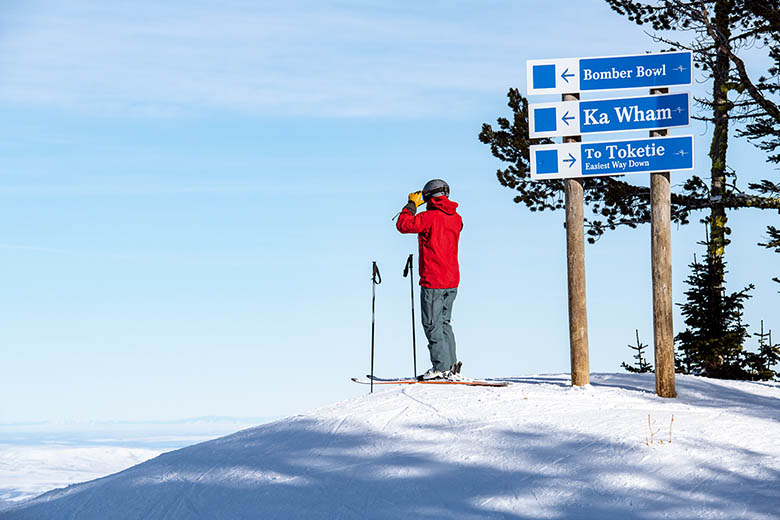
Switchback Travel (Jason Hummel)
If there is one piece of gear that will keep first timers from sticking with the sport, it’s an uncomfortable ski boot. An ill-fitting cheap boot can pinch and freeze toes, turning potential fun into complete misery. Thankfully, there are quality options even in the entry-level market. Part of the reason is that most beginner boots are based on more expensive models but with a roomier fit and a softer forward flex. Our top picks for the 2024 season cover boots for true beginners up to progressing intermediates that require greater stiffness and performance. For more information, see our comparison table and buying advice below the picks. And to complete your ski gear setup, see our article on the best skis for beginners.
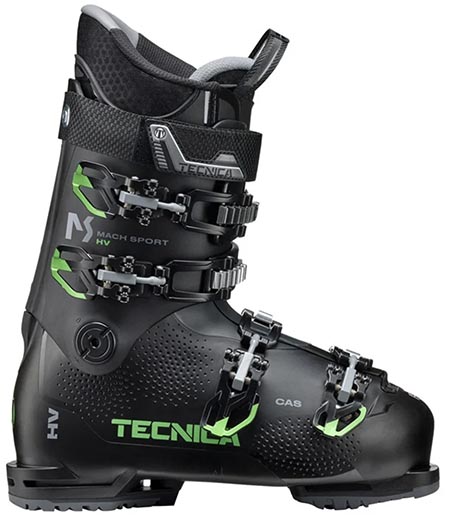 Last: 103mm
Last: 103mm
Flex: 80, 75W
What we like: Nice mix of price, comfort, and performance for beginners.
What we don’t: Too wide for narrow feet and fast learners will want a little more stiffness.
Beginning skiers look for comfort, ease of use, and warmth for their first pair of boots, and the Tecnica Mach Sport HV 80 provides all of those in spades. Coming from one of the most respected brands in the business—their Mach1 is one of our favorite top-end downhill models—this popular design includes nice touches like high-quality aluminum buckles, cozy liner, GripWalk soles, and a smooth and reliable flex. You also get a medium/wide last and accommodating shape in general, which limits pinch points to maximize warmth and comfort for most foot types (plus, the shell can be easily customized by a bootfitter). And the Mach Sport is priced right at $350 for the moderate 80-flex version.
What are the downsides of the Mach Sport HV 80? Its 103-millimeter last isn’t the widest on the market, but the fit is pretty generous all around, which can be a problem for those with narrow calves and feet. Moreover, we think fast learners should invest in a boot with a stiffer flex (Tecnica does offer the Mach Sport in a 90 flex for men and an 85 flex for women, although price increases to $400 and $500 respectively). Overall, despite a couple nitpicks, we think the Mach Sport HV is a good value and a fantastic starter boot.
See the Men's Mach Sport HV 80 See the Women's Mach Sport HV 75
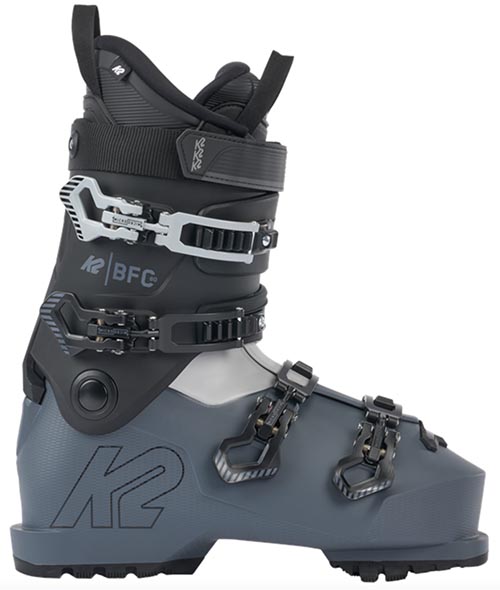 Last: 103mm
Last: 103mm
Flex: 80, 75W
What we like: A great boot for hard-to-fit feet; competitive price.
What we don’t: High-volume fit won't be for everyone.
If you love to ski but balk at the pain of wearing your boots all day, the K2 BFC 80 (BFC stands for “built for comfort”) could be a good solution. Its 103-millimeter last, high-volume shape, heat-moldable shell, and extra-cushy liner add up to an impressively premium and plush feel. The entry-level 80-flex version here is reasonably priced at $300 and lines up nicely for beginners, but stepping up to the $400 BFC 90 (or women’s BFC 85) gets you a slightly higher performance threshold. All told, if you’re a novice skier who hates ski boots, the K2 BFC collection is certainly worth a look.
That being said, the K2 BFC line does have some limitations. First, the cushy liner that makes the boot so comfortable does impact power transfer and precision, so it’s not a great option for those with carving ambitions (the Mach Sport above wins out here). We’re also disappointed that the 80- and 90-flex BFCs don’t include a walk mode, which can make it much easier to hike into the sidecountry, trudge across the parking lot, or climb stairs at the lodge. Wide-footed skiers who put a premium on comfort likely won’t mind these tradeoffs, but they are potential drawbacks for those quickly advancing their skills.
See the Men's K2 BFC 80 See the Women's K2 BFC 75
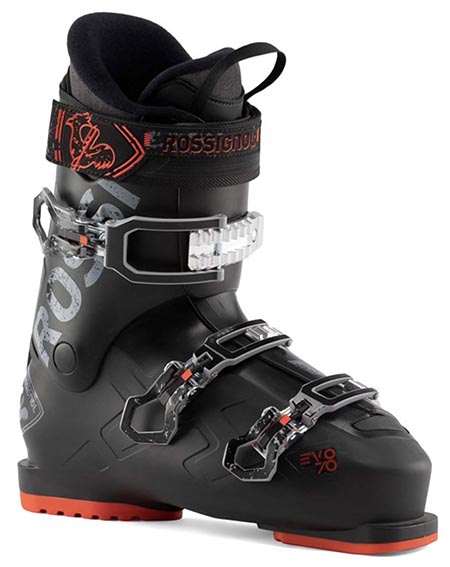 Last: 104mm
Last: 104mm
Flex: 70, 50W
What we like: Good price for a well-rounded option for true beginners.
What we don’t: Pretty basic liner and only three buckles.
The Rossignol Evo 70 is the entry-level offering from the venerable ski brand, featuring their softest flex, widest last, and cheapest price. The setup mirrors most other beginner boots in specs, but nearly all of the extras have been stripped away. You don’t get a heat-moldable liner (not a huge loss) or a second buckle at the top (a downside for dialing in the fit), but Rossi got the basics right with a forgiving flex, nicely shaped shell (a softer plastic at the front helps make it easier to take on and off), and reliable aluminum buckles and power strap.
Like the $30-pricier Nordica Cruise 70 below, the Evo is a solid deal at just over $200 for those that want a true starter boot. Overall, we think it’s a great match for first-timers wanting to avoid rentals or a lightweight advancing beginner—perhaps a teenager that hasn’t hit that major growth spurt. However, the plastic shell is quite basic, and the same can be said of the fairly generic liner, which is enough to keep the Evo from overtaking the more well-rounded and capable Tecnica above.
See the Men's Rossignol Evo 70 See the Women's Rossignol Kelia 50
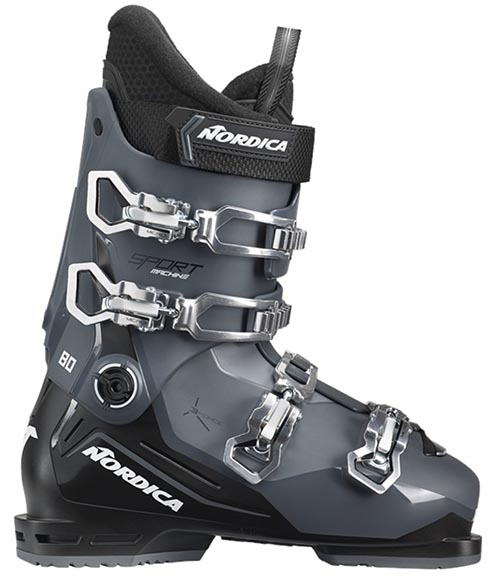 Last: 102mm
Last: 102mm
Flex: 80, 65W
What we like: Soft liner, easy step in, and a not-too-wide fit.
What we don’t: A small step down in quality from the Tecnica above.
Sliding under their high-performance and well-respected Speedmachine collection is Nordica’s Sportmachine. This mid-range line puts an emphasis on comfort with a plush and reasonably cushy cork liner and easy step-in thanks to soft plastic at the front of the shell and a generous opening. In terms of stiffness, the 80-flex men’s/unisex model is a good option for progressing beginners, while the 65-flex women’s is best for those just starting out and/or lightweight skiers. All told, it hits a sweet spot for a lot of riders looking to graduate from their rental kit.
How does the Sportmachine 3 stack up to the Tecnica Mach Sport above? Both are detuned variations of high-quality resort boots, and their price, flex, and liner comfort are also quite similar. The Mach Sport has a slightly higher-volume fit, so the Sportmachine will be better for those with average to narrower feet (although both are fairly roomy to avoid being too tight and restrictive). But the Tecnica gets the slight edge in quality with GripWalk soles (the Nordica uses traditional alpine ISO 5355 soles) and a more customizable shell. In truth, there’s not a whole lot that separates the two, and a decision will likely come down to fit and availability.
See the Men's Nordica Sportmachine 3 80 See the Women's Sportmachine 3 65
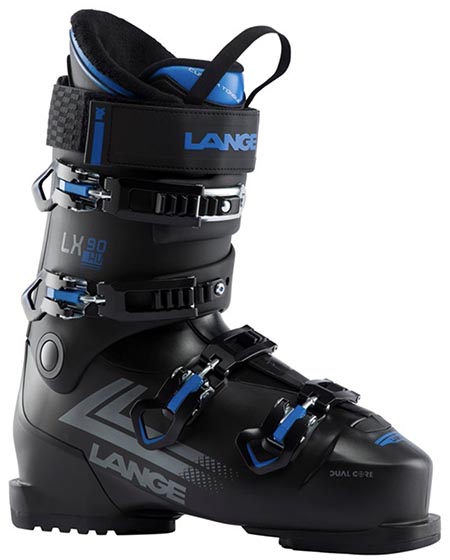 Last: 102mm
Last: 102mm
Flex: 90, 70W
What we like: Lange quality and a lower-volume fit.
What we don’t: Too stiff for the average beginner.
Typically, we wouldn’t recommend a boot with a 90-flex rating for a beginner, but not all first-timers progress in a slow and steady manner. If you think you’ll be carving on your edges in short order, then the LX 90 (or women’s LX 70) is where we’ll lead you. Lange doesn’t dabble much with introductory models—this is their softest-flexing on-piste boot—and as such, you don’t see the typical entry-level features. The stiffer mono-injected shell combined with four strong buckles and a power strap are a far cry from the boots above, and they add up to a fairly high level of power transmission.
The extra stiffness may be intimidating coming from soft rental boots, but we think stronger beginners and intermediates will find the LX 90 to be a good pairing. We would prefer a hike mode for easier walkability to and from the car, but at $350, that might be getting a little greedy. Finally, if you like the LX’s design but need a narrower fit, Lange’s Shadow MV line trims the last width from 102 to 100 millimeters (although the softest and cheapest Shadow is the 110-flex model for $650).
See the Men's Lange LX 90 See the Women's Lange LX 75
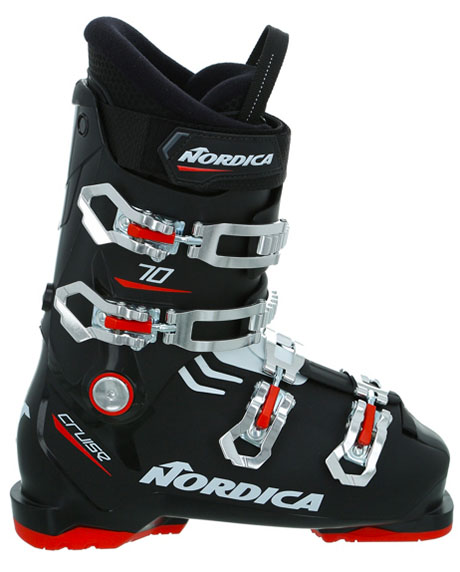 Last: 104mm
Last: 104mm
Flex: 70, 65W
What we like: Heat-moldable liner at a budget price.
What we don’t: Super-soft flex is only for true beginners.
If your perfect day of skiing involves casual sweeping turns and plenty of time socializing, the Nordica Cruise 70 is a great pairing. With a very soft flex and surprisingly comfortable liner, the Cruise checks the right boxes for a serviceable cheap boot. What sticks out at the $250 price point is the heat-moldable liner, which helps expedite the break-in process. Plus, its aluminum buckles are a nice touch and help boost longevity (some entry-level designs use plastic).
The Cruise's classic four-buckle layout is unexpected given the very soft build—most manufacturers opt for three for simplicity and ease of entry and exit—but it does allow for micro adjustments to the fit. From a performance standpoint, there’s little to compliment, and we recommend avoiding the Cruise if you have aspirations for turning quickly on edge or exploring off trail. But if you prioritize comfort above all else, the 70-flex model is all the beginning or casual skier needs.
See the Men's Nordica Cruise 70 See the Women's Nordica Cruise 65
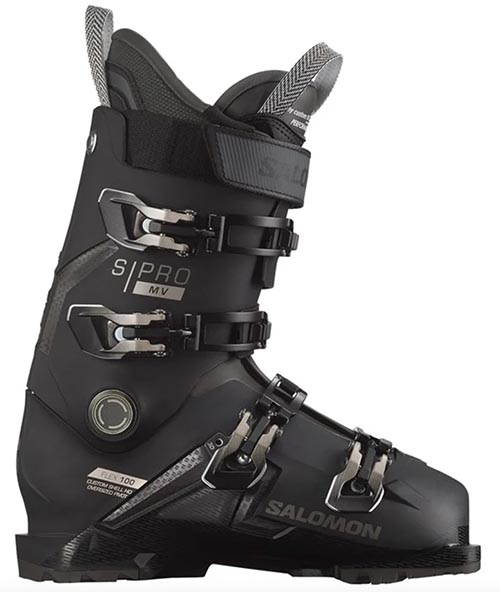 Last: 100mm
Last: 100mm
Flex: 100, 90W
What we like: A nice option for ambitious beginners.
What we don’t: Big investment for those just starting out.
Stepping up in strength and comfort is the Salomon S/Pro 100, which replaced the uber-popular X Pro line that had been a favorite among intermediate riders (earning it a consistent spot in our best downhill ski boot article). With the latest model, they’ve stuck to the winning formula: medium-width last, mid-range stiffness, and premium liner. All-around performance is excellent with a smooth flex that works well for both lightweight and powerful skiers, and the build quality is exactly what we expect from the venerable French brand. Moreover, for dialing in fit, the S/Pro is a standout with its heat-moldable liner and shell.
The S/Pro’s increased flex over the Lange LX above and plush liner pushes the price to a hefty $500, which is a significant investment for a beginner (although they actually decreased the MSRP $50 for last winter). As with the Lange, this is not the boot we’d recommend for those still debating whether they want to stick with the sport. But with one of the most foot-friendly designs on the market, as well as the performance and durability to last you for many years, the extra cost may be worth it.
See the Men's Salomon S/Pro 100 See the Women's Salomon S/Pro 90
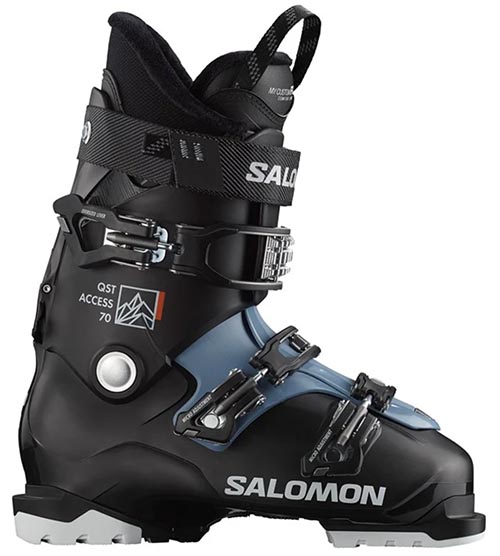 Last: 104mm
Last: 104mm
Flex: 70, 60W
What we like: Cozy and warm liner; walk mode is nice for trudging through the parking lot.
What we don’t: So-so value.
Salomon’s S/Pro above is a perennial best-seller, but the brand’s QST Access line is better targeted to the beginner market. Comfort was a clear priority with the super-wide 104-millimeter last and soft and cushy interior. And they checked the right boxes for convenience-minded skiers with a walk mode that makes it easier to schlep your gear to and from your car and a pretty standard 3-buckle design. Finally, the quality is up to Salomon’s usual standards, with a well-made and long-lasting shell and nice touches like a wool blend layer in the liner for added coziness.
At $350 and with a 70-flex rating (the women’s 60 is also $350), the QST Access is not a strong value. Unless you put a premium on the walk mode or small upgrade to the liner, alternatives like the Rossignol Evo 70 or Nordica Cruise 70 above will provide similar levels of performance for less. Plus, our top-rated Tecnica is equally well-made and has a higher flex yet costs the same. In the end, we’re a bit torn with the QST Access: It’s clearly a step above the aforementioned Evo or Cruise, but the reality is that most beginners are better off saving a bit of money (and putting off a larger investment on a higher-end, stiffer model once their skills progress).
See the Salomon QST Access 70 See the Women's Salomon QST Access 60
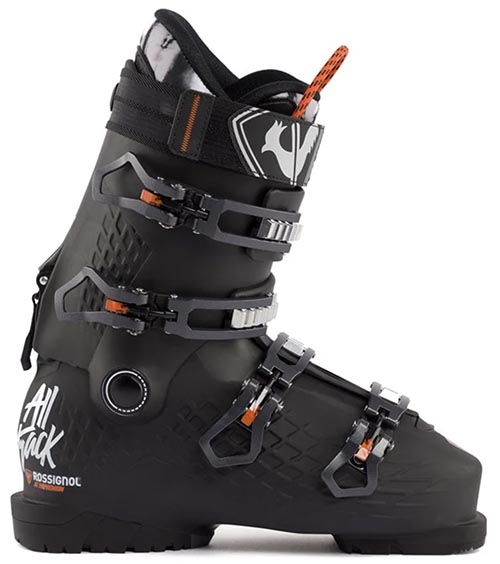 Last: 102mm
Last: 102mm
Flex: 90, 80W
What we like: Good price for an all-mountain design.
What we don’t: Most beginners don’t need the sidecountry features.
In contrast to Rossignol’s simple Evo above, the Alltrack 90 is a feature-rich all-mountain boot. Sitting at the bottom of the Alltrack line that reaches as far as $800+ Pro and Elite models, the “90” retains most of the good stuff at about half the price. And among the beginner-friendly options on the market, it’s our favorite for sidecountry use. The hike mode and compatibility with GripWalk soles (sold separately) work well for quick treks off trail. And on the downhill, the smooth medium flex and strong four-buckle design give you confidence to lean into a turn.
The 90 flex rating makes it a solid option for advancing beginners, but the Alltrack falls mid-pack on our list for a couple reasons. First, most beginners don’t want or need the hiking features, and we think the Lange LX 90 is more comfortable overall (and saves you $80). And the Salomon S/Pro has a better liner and more precise fit. But the Alltrack 90 can be a great all-rounder for those skiing at resorts with easy off-piste access. For a simplified alternative from Rossi, check out their Track line (104mm last), which is one of only a few beginner boots to feature a walk lever.
See the Men's Rossignol Alltrack 90 See the Women's Rossignol Alltrack 80
| Boot | Price | Last | Flex | Other Flexes | Buckles |
|---|---|---|---|---|---|
| Tecnica Mach Sport HV 80 | $350 | 103mm | 80, 75W | 65W, 70, 85W, 90, 100, 110, 120 | 4 w/35mm strap |
| K2 BFC 80 | $300 | 103mm | 80, 75W | 85W, 95W, 100, 105W, 120 | 4 w/30mm strap |
| Rossignol Evo 70 | $220 | 104mm | 70, 50W | None | 3 w/40mm strap |
| Nordica Sportmachine 3 80 | $300 | 102mm | 80, 65W | 75W, 85W, 90, 95W, 100, 120, 130 | 4 w/35mm strap |
| Lange LX 90 | $350 | 102mm | 90, 70W | 80W, 90W, 100, 120, 130 | 4 w/40mm strap |
| Nordica Cruise 70 | $250 | 104mm | 70, 65W | 75W, 85W, 90, 120 | 4 w/35mm strap |
| Salomon S/Pro 100 | $500 | 100mm | 100, 90W | 80, 100W, 120, 130 | 4 w/35mm strap |
| Salomon QST Access 70 | $350 | 104mm | 70, 60W | 70W, 80, 90 | 3 w/35mm strap |
| Rossignol Alltrack 90 | $430 | 102mm | 90, 80W | 70W, 110, 120 | 4 w/40mm strap |
While there isn’t a comprehensive definition in the market of a beginner boot, the picks above do share a number of common characteristics. To start, these boots are more value-oriented (but good ones aren’t the cheapest around), packing fewer features and a more basic liner than high-end options. They also offer the most flex and the roomiest fit, unlike performance boots which are stiff and low-volume to help transmit as much power as possible to the skis. Given their more generous fit, they’re also the most comfortable to slide into, the warmest since they don’t create as many pinch points, and the least likely to cause foot or shin pain after a day on the slopes.
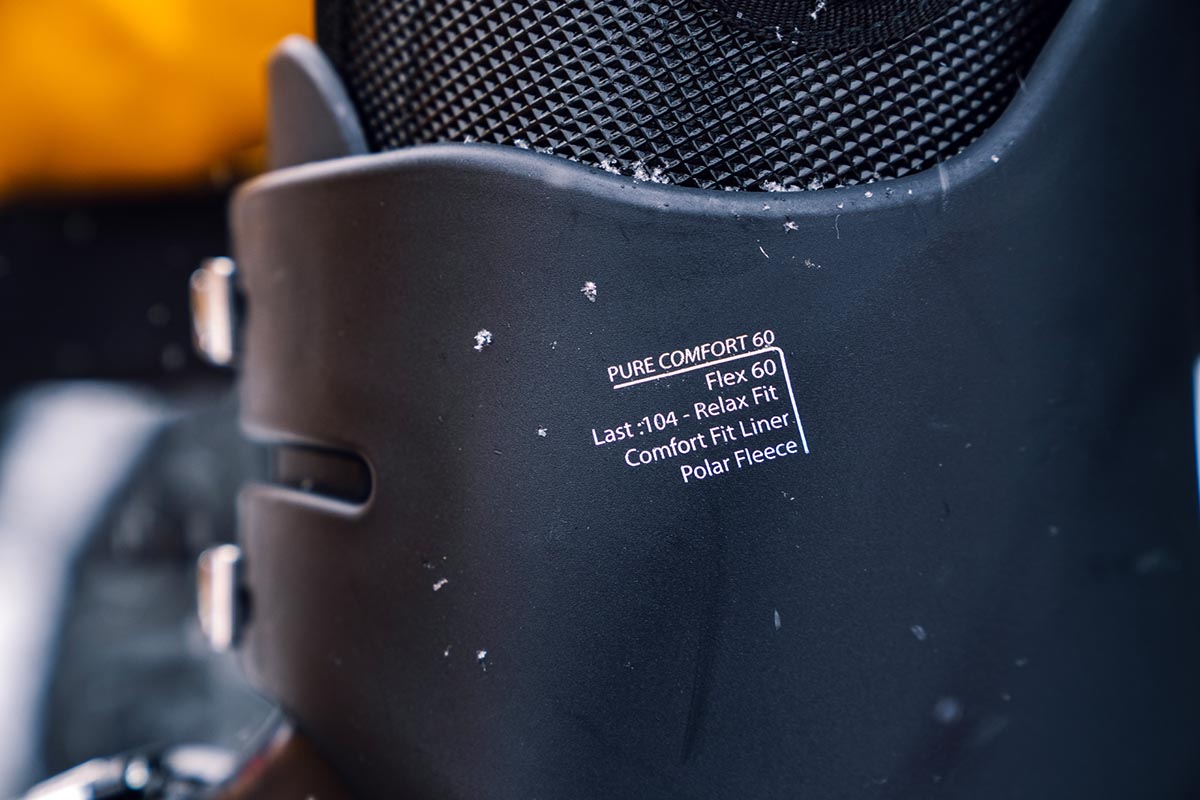
Of note: the limited performance potential of a beginner boot does mean it's best for the intermediate or advancing skier to avoid them altogether. Those skiers should instead read our article on the best downhill ski boots.
Because of the focus on the beginning skier, the best terrain for these boots is cruising your green circle or blue square runs at the resort. The boots on this list are often the detuned and softer version of dedicated downhill boots, and this is reflected in their performance. Steep and technical terrain requires fast inputs and changes of direction—both things that a soft and flexible boot will not provide. As a result, boots like our top-rated Tecnica Mach Sport HV 80 perform best on groomed runs and at a more subdued pace. Stepping up to a boot like the Rossignol Alltrack 90 gets you more all-mountain versatility and stiffness.
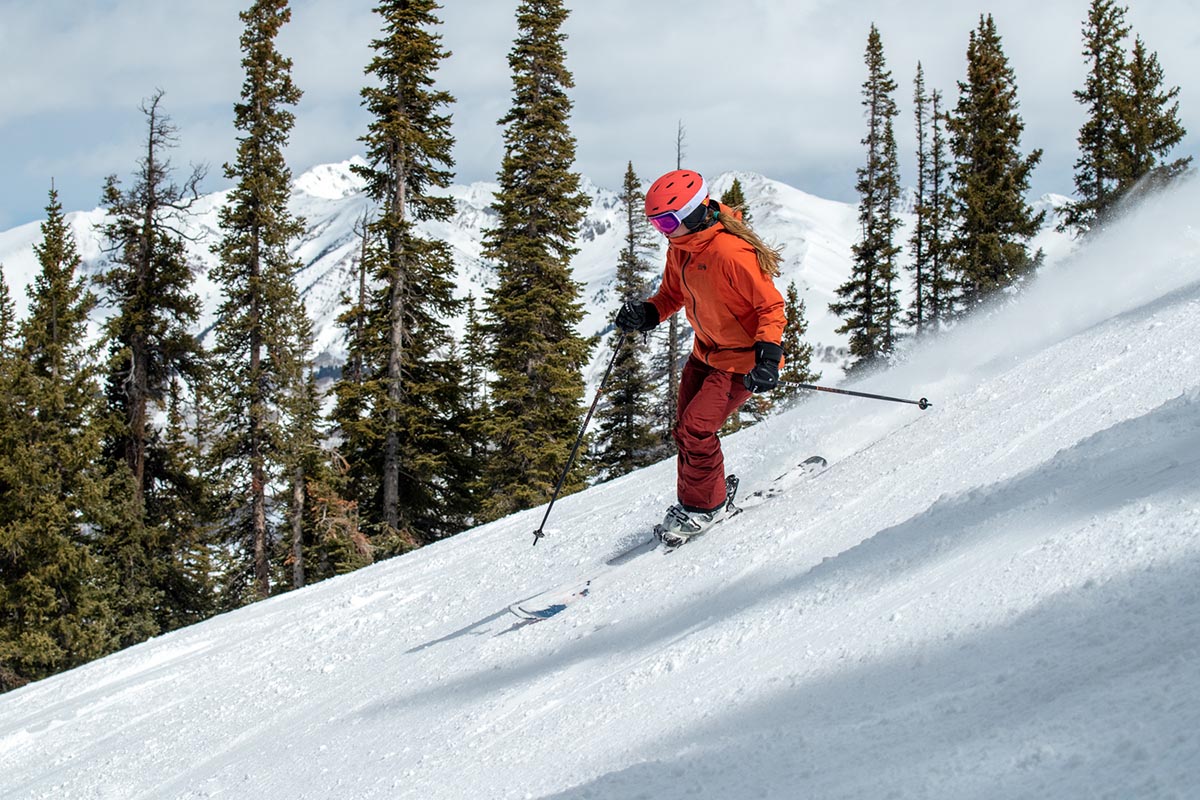
In many ways, a beginner boot is defined by its flex rating. Every downhill boot on the market is given a flex index number ranging from approximately 60 to 130. Lower numbers are softer, have more give, and are more comfortable, making them ideal for beginner skiers. Moving up in stiffness to intermediate and advanced models gets you a boot that isn't as cushy but more efficiently transfers your inputs to the bindings and skis. Determining whether or not you want to upgrade to a high-end boot right off the bat is one of the considerations you need to make. Are you anticipating advancing quickly? If so, it may be worth getting a boot like the Lange LX 90 as opposed to purchasing new boots after only a season of use. A preferred stiffness also correlates with your body weight, so lighter skiers are often better off with a lower flex rating relative to performance. Below are general recommendations; there are ranges within ranges that we dig into later.
Beginner: 60-90
Intermediate: 90-110
Advanced: 100-120
Expert: 120+
Within the beginner category, there can be a further breakdown of what’s considered a “true beginner” with a super-soft flex. This falls into the 50 to 70 flex range, and lightweight skiers desiring the cushiest setup should find a suitable boot here. Heavier skiers will be better off with a boot that is more substantial for improved support. Something with a flex of 80 to 90 is a great starting point. This second category is also suitable for lighter-weight advancing beginners or intermediates.
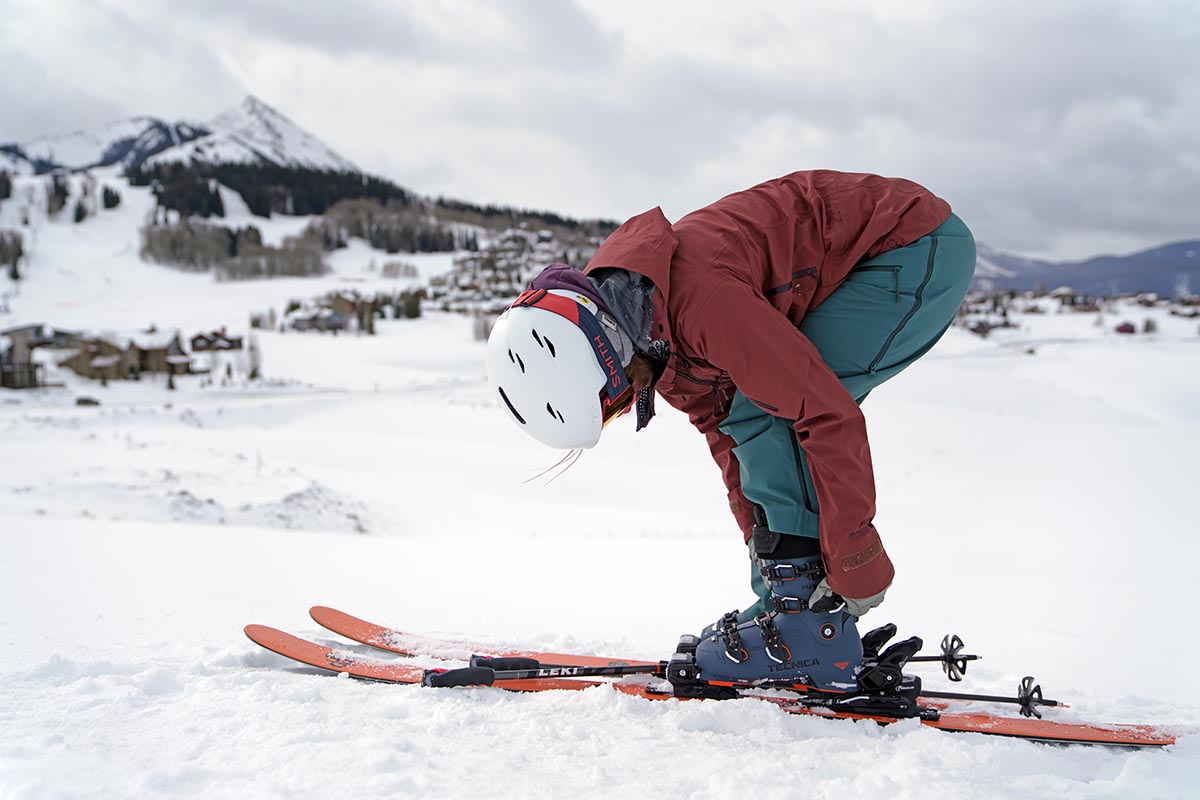
Both men’s and women’s ski boots are listed in unisex Mondo (or Mondopoint) sizing: the length of your foot measured in centimeters. You can measure your foot by tracing its outline on a piece of paper or marking the bottom of the heel and top of the toes. If your foot measures 30 centimeters in length, your Mondo size is 30. Getting measured in a ski shop is preferred, but this is a rough way to do it at home.
Every manufacturer or retailer provides a sizing chart that matches shoe sizes to ski boot sizes (here's Evo's chart), but your actual Mondo size may be a size or two smaller than what you see on the chart. This is because a tight fit is recommended with ski boots. Ski boot liners are made of foam and will pack out and mold to your feet over time, so it’s best to start with a relatively snug fit and wear them in.
After the flex rating, the most common specification listed for ski boots is last. This measurement is based on the width of the forefoot and listed in millimeters. Most manufacturers make ski boots with varying lasts to accommodate those with narrow, average, and wide feet. Additionally, the last is an indicator of performance, as a lower-volume fit serves as a responsive conduit between you and your skis. On the casual end, boots are going to fall in an average to wide width, which should fit all but the narrowest feet just fine.
Narrow: 96-98mm
Average: 99-102mm
Wide: 103mm+
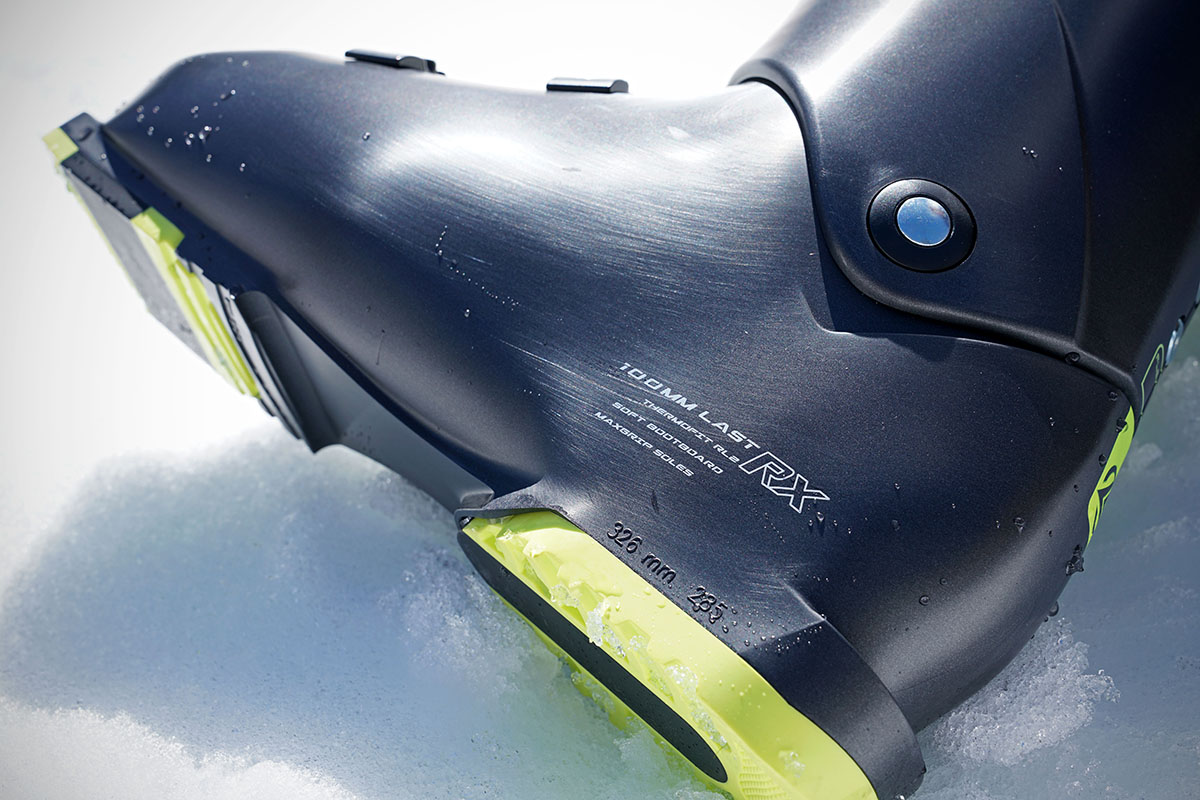
Most beginner ski boots are made up of two independent pieces: a hard plastic outer shell that provides structure and strength and a removable liner that delivers comfort, support, and insulation. The liner is filled with varying amounts of foam, depending on the type of skiing the boot is intended for. Within the entry-level category, these liners are going to put a premium on cushion rather than performance, so they will have a soft and inviting feel. Intermediate and advanced models will be firmer, which brings the added benefit of improved energy transfer to your skis. The liner should be comfortable but reasonably tight around your foot. Your liner will conform to your feet, so don’t be too concerned if it feels snug at first. However, you’ll need to size up if your toes are pressing against the hard-sided shell.
Heat-moldable liners are found on a number of our favorite beginner boots, including the Salomon S/Pro, and can be custom fit to your feet in a ski shop that has the necessary equipment. This is a nice way to get the liner to fit your feet right out of the box, but isn’t mandatory for most folks. You can get much of the same fitting accomplished just by wearing the liners around the house or in a few early-season ski days.
To start, it’s helpful to know that there aren’t a lot of revolutionary buckle and strap designs in the beginner-to-intermediate category. The biggest differences you’ll see are the number of buckles used. Some use the classic four-piece, which offers improved adjustability but are a bit more of a pain to get on and off. Others opt for two or three buckles for greater simplicity. Either option can work well for a beginner, and we’ve had success with both designs. We always recommend looking for buckles made mostly with aluminum for greater durability (plastic is cheaper but more prone to breaking).
The strap at the top of the boot near the cuff is another important piece of the design. Sometimes referred to as the power strap, it keeps that top portion nicely locked into place to help bring out the full performance potential of your boots—and at a lower weight and more comfort than adding another buckle. Having a full compliment of buckles as well as a quality power strap also helps in really dialing in the fit, which can make accommodating varying sizes of legs and calves that much easier.
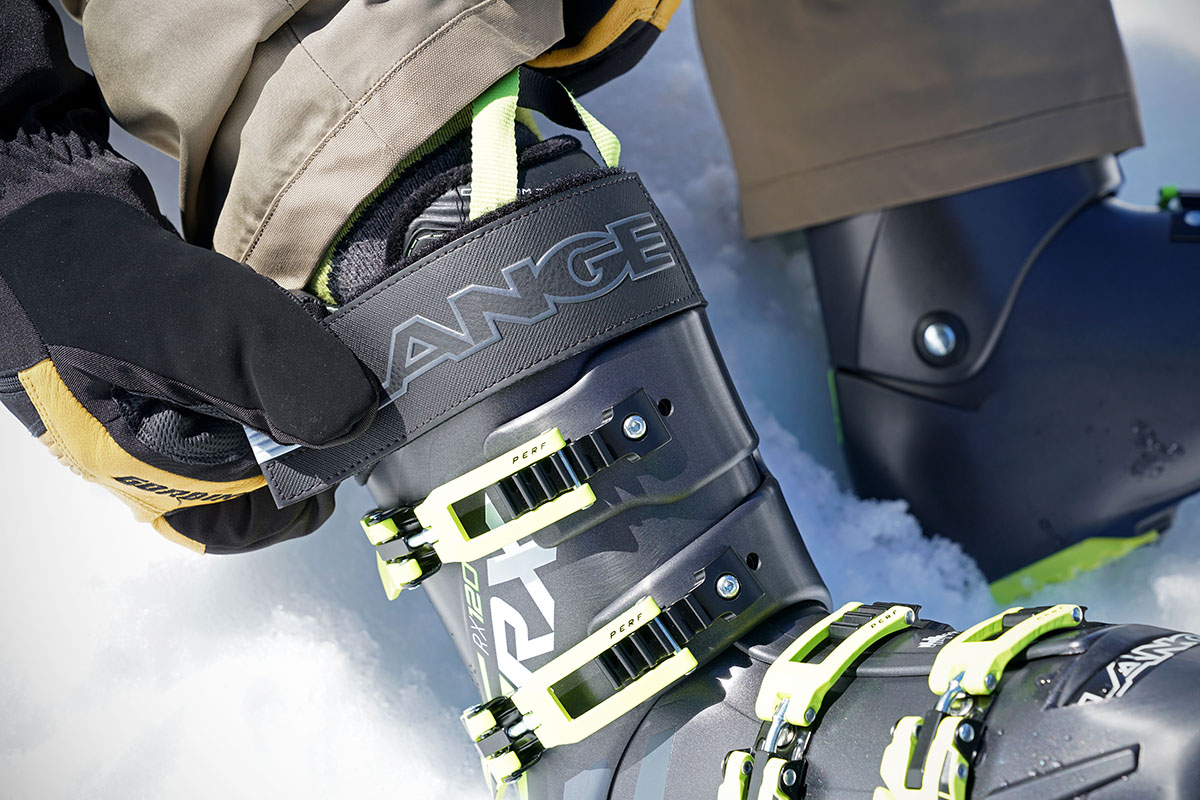
Within the beginner ski boot category, you’ll see two different styles of boot soles: ISO 5355 models and GripWalk-equipped designs (ISO 23223). Starting with the former, ISO 5355-compatible boots are mostly flat underfoot and sized to fit and release from the toe piece on a standard alpine binding. The main downside is walking and hiking comfort: their shape and simple outsoles lead to an awkward gait and can be quite slippery in anything from hardpack snow and ice to slick bathroom floors.
Enter the newer GripWalk sole, which has a rockered shape for a more natural stride and softer plastic/rubber compound for improved traction. These are commonly found on higher-end boots, like the $500 Salomon S/Pro, although there have been trickle-down signs of late. Our top-rated Tecnica Mach Sport 80, for example, added GW soles for this winter. If you do opt for a GripWalk boot, you’ll want to make sure your ski bindings are compatible. A growing number are GW-ready, especially among mid-range and high-end designs, but many entry-level bindings are not.
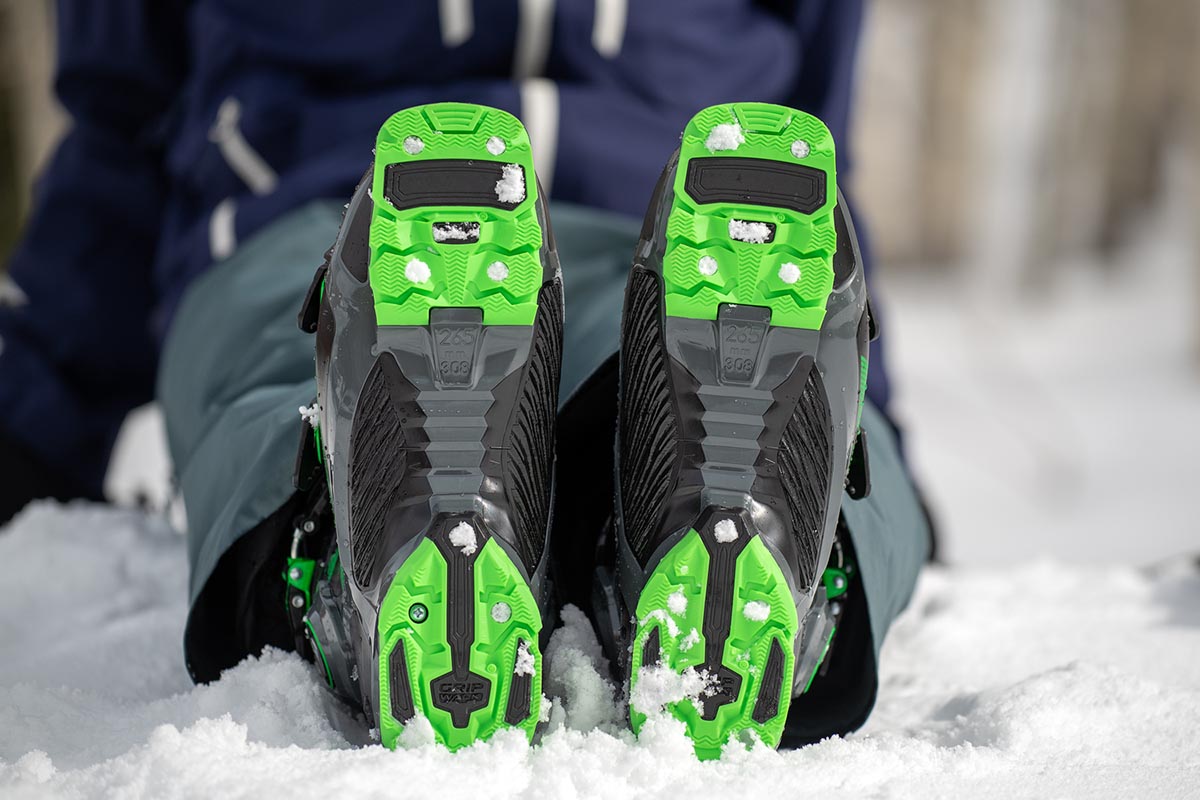
A proper ski system is just that: a system that has all pieces working in concert. This is just as important for a hard-charging expert as it is for a beginner. As such, it’s best to pair your softer-flexing boots with binding and skis that are equally as forgiving. Entry-level skis and bindings often come as a single, integrated system, and we break down the best options in our best skis for beginners article.
Back to Our Top Beginner Boot Picks Back to Our Beginner Boot Comparison Table